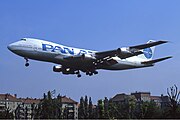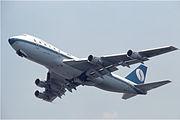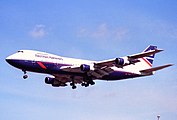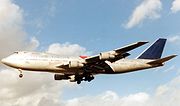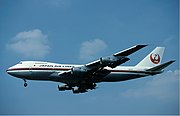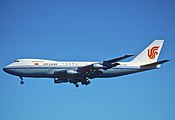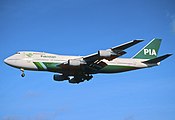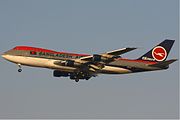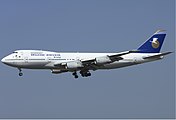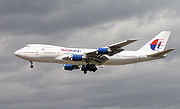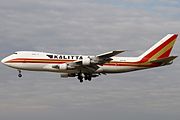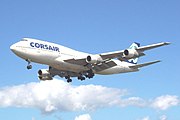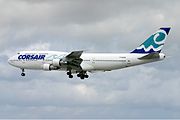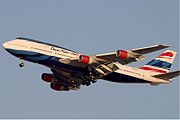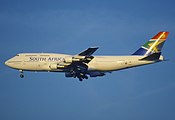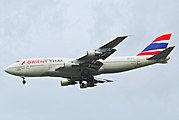Talk:Boeing 747/Archive 4
| This is an archive of past discussions. Do not edit the contents of this page. If you wish to start a new discussion or revive an old one, please do so on the current talk page. |
| Archive 1 | Archive 2 | Archive 3 | Archive 4 | Archive 5 |
747SP range
Just pointing out a problem for which I have no solution. The 747SP range listed in the specifications table here is inconsistent with the table entry in the 747SP article, but more importantly, grossly inconsistent with the whole concept of the SP as a longer-range version of the 747-200, since both this article and the SP article show the SP as having a much shorter range than the 747-200. Also the published data about the 747SP delivery flights from Everett, WA to Cape Town, SA says those flights covered a distance of 10,215 miles with two hours of reserves. They carried extra fuel, but it amounted to only a few percent. All this leads me to the conclusion that the SP's actual range must be considerably in excess of what is stated here... but I haven't found a reliable source that would justify any changes. Maybe someone else will have better luck. 76.22.118.146 (talk) 05:23, 17 March 2017 (UTC)
- The SP (700,000lb mtow) is a -100 (735,000lb mtow) shrink, not a -200 (833,000lb mtow) derivative, so it's longer range than the -100 but was dropped since the -200 was better. The 747SP was wrong, it's updated from the obviously reliable Boeing source with both : Boeing 2007. Delivery flights are without payload (and PAE-CPT benefits from tailwinds: 511 knots average for 17h22), so it could reach further (see the PL/range chart in the ref, perhaps 8000nm ESAD with aux tanks). --Marc Lacoste (talk) 10:04, 20 March 2017 (UTC)
- You're right about the -100 point; I should have said "alternative to" rather than "version of." But Boeing continued to represent the SP as the longest-range 747 variant long after the -200B became available, and airlines continued to buy it for that reason. See Flight 1975 for example where the SP's range is shown as 5,700 nm vs. 5,280 nm for the -200B. Maybe we need something more than the raw data to resolve or at least explain the apparent contradiction. 76.22.118.146 (talk) 22:33, 25 March 2017 (UTC)
- In this 1975 Flight article, the SP taxi gross weight is 663,000lb vs 778,000lb for the -200, which explains why the -200 ended up having a similar range later at 833,000lb mtow as showed in the recent 2007 Boeing ref.--Marc Lacoste (talk) 11:51, 26 March 2017 (UTC)
- A little more information. A document titled "SAA 747 SP delivery flight special instructions" at the Harl V. Brackin Library at the Museum of Flight in Seattle (online catalog record at [1] ) gives the following figures for the fuel capacity of the first 747SP delivered from Everett, WA, USA to Cape Town, South Africa: Total fuel loaded, 398,371 pounds. Fuel at takeoff: 396,063 pounds, broken down as 269,156 pounds in the wing tanks, 112,691 pounds in the center tank, 13,399 pounds in the "pillow" tanks in the cargo bays, and 817 pounds in the fuel manifolds and lines. According to separate press coverage, the fuel used was PhilJet A-130, a high-energy fuel, but I can't find the density or other specifications of that fuel, so I can't calculate the volumetric fuel capacity of this particular 747SP from the fuel weight. The wing and center tank figures add to 381,847 pounds, however, and if the weight of A-130 is somewhere between Jet A and Jet A-1, the volume of the fuel would be somewhere between 55,945 and 57,029 US gallons, well above than the capacity stated in that Boeing document you cite above (50,259 US gallons). Since it's well known that Boeing offered customers more customization options than it described publicly, it's quite possible that the SAA aircraft were equipped to hold more fuel and therefore had more range than the reference aircraft described in the Boeing document. 76.22.118.146 (talk) 01:47, 26 March 2017 (UTC)
hull losses and total fatalities in the lede?
The lede should provide summary information that's useful. A large plane with a long history will show a large number of fatalities which, without context, is useless information. How about "fatalities per passenger mile" or something? — Preceding unsigned comment added by 68.175.11.48 (talk) 06:13, 8 April 2017 (UTC)
- Its not something we would usual do in the lead unless it was a well reported issue like the F-104, it is in this case mentioned in the accidents and incidents section. MilborneOne (talk) 08:00, 8 April 2017 (UTC)
- It's certainly not useless since it's the main point on the subject. Per WP:LEAD, the lead should summarise the sections and the sentence adequately summarise Boeing_747#Accidents_and_incidents. Fatalities per RPK is a higher level concept which isn't even present in the section, and for which we should have a WP:reliable source. There is Boeing's Statistical Summary of Commercial Jet Airplane Accidents showing the Hull loss with/without fatalities accident rate per million departures though.--Marc Lacoste (talk) 08:08, 8 April 2017 (UTC)
Main pic
As discussed in Talk:Boeing_737#Infobox_picture, a 747-100/200/300 pic would be more opportune here as it exists the SP, -400 and -8 articles with their own version main pic. Of course vintage pics will have vintage liveries and grainy film photos, but they convey also the era of the aircraft.--Marc Lacoste (talk) 10:36, 27 June 2017 (UTC)
- Current -400
Extended content
|
|---|
|
As I went trough classic 747 pics, it struck me the most obvious would be a Pan Am, as the airline was so influential in its design. Here are the 3/4 views I picked:
The fourth (Clipper Unity) looks good.--Marc Lacoste (talk) 10:36, 27 June 2017 (UTC)
- I would support a change to Clipper Unity. MilborneOne (talk) 16:03, 27 June 2017 (UTC)
- Pan Am 747 would have historical value. May I suggest the following, which is very similar to the Clipper Unity photo (although that one is good)? This one (Clipper Storm King) is a bit less grainy. Oh and as a side note it's N732PA, which is the 3rd 747 built and was part of the 747 test fleet! Regards, SynergyStar (talk) 16:07, 27 June 2017 (UTC)
- Indeed Storm King is even better--Marc Lacoste (talk) 16:58, 27 June 2017 (UTC)
- Thanks for suggesting these photos. I think several years back a PA 747 photo was considered, but at the time the selection to choose from on Wiki was more limited. Photo going up shortly. Regards, SynergyStar (talk) 17:02, 27 June 2017 (UTC)
- Indeed Storm King is even better--Marc Lacoste (talk) 16:58, 27 June 2017 (UTC)
External links modified
Hello fellow Wikipedians,
I have just modified 6 external links on Boeing 747. Please take a moment to review my edit. If you have any questions, or need the bot to ignore the links, or the page altogether, please visit this simple FaQ for additional information. I made the following changes:
- Added archive https://web.archive.org/web/20071214134934/http://oea.larc.nasa.gov/PAIS/Partners/C_5.html to http://oea.larc.nasa.gov/PAIS/Partners/C_5.html
- Added archive https://web.archive.org/web/20071214134934/http://oea.larc.nasa.gov/PAIS/Partners/C_5.html to http://oea.larc.nasa.gov/PAIS/Partners/C_5.html
- Added archive https://web.archive.org/web/20071217151126/http://www.geae.com/engines/commercial/cf6/history.html to http://www.geae.com/engines/commercial/cf6/history.html
- Added archive https://web.archive.org/web/20071226032720/http://www.memagazine.org/supparch/flight03/jetsfans/jetsfans.html to http://www.memagazine.org/supparch/flight03/jetsfans/jetsfans.html
- Added archive https://web.archive.org/web/20071220020946/http://www2.mst.dk/common/Udgivramme/Frame.asp?pg=http%3A%2F%2Fwww2.mst.dk%2Fudgiv%2FPublications%2F2003%2F87-7972-489-2%2Fhtml%2Fkap09_eng.htm to http://www2.mst.dk/common/Udgivramme/Frame.asp?pg=http%3A%2F%2Fwww2.mst.dk%2Fudgiv%2FPublications%2F2003%2F87-7972-489-2%2Fhtml%2Fkap09_eng.htm
- Added archive https://web.archive.org/web/20090211082459/http://www.businessday.co.nz/world/4842143 to http://www.businessday.co.nz/world/4842143
When you have finished reviewing my changes, you may follow the instructions on the template below to fix any issues with the URLs.
This message was posted before February 2018. After February 2018, "External links modified" talk page sections are no longer generated or monitored by InternetArchiveBot. No special action is required regarding these talk page notices, other than regular verification using the archive tool instructions below. Editors have permission to delete these "External links modified" talk page sections if they want to de-clutter talk pages, but see the RfC before doing mass systematic removals. This message is updated dynamically through the template {{source check}} (last update: 18 January 2022).
- If you have discovered URLs which were erroneously considered dead by the bot, you can report them with this tool.
- If you found an error with any archives or the URLs themselves, you can fix them with this tool.
Cheers.—InternetArchiveBot (Report bug) 22:00, 22 July 2017 (UTC)
Squeezing in another image?

I just came across this image, which is featured on Commons, and it occurred to me that we don't currently have a single FP of the queen of the skies here on enwiki, despite the multitude of photos that exist of it. I think this one has a fair chance: it's technically good and illustrates the takeoff well, showing the undercarriage, flaps and exhaust, with the control tower and terminal in the background providing context. Question is how to squeeze it into an already well illustrated article? --Paul_012 (talk) 20:49, 26 July 2017 (UTC)
- That's a 747-400. That image could replace one of images in the 747-400 variant section. If this does not work out here then check Boeing 747-400. --Finlayson (talk) 21:09, 26 July 2017 (UTC)
Semi-protected edit request on 30 August 2017
This edit request to Boeing 747 has been answered. Set the |answered= or |ans= parameter to no to reactivate your request. |
Request you review "hull loss" information. A hull loss is an aviation accident that damages the aircraft beyond economical repair, resulting in a write-off. The source (Aviation Safety Network) counts all damage to aircraft, not just those that fit the above definition, but also those that were repaired and returned to service. The correct number of 747 hull losses is probably 29. The source is Wikipedia article "List of accidents and incidents involving commercial aircraft". Eugene.neiman (talk) 17:31, 30 August 2017 (UTC)
- The total listed in the Aviation-safety.net page is actually hull losses and accidents. I updated the numbers in the article section and corrected the wording to match. So I think this is resolved now. Note that other wiki pages are not reliable references on Wikipedia (see WP:RELIABLE). --Finlayson (talk) 18:51, 30 August 2017 (UTC)
 Note: Marking as answered. jd22292 (Jalen D. Folf) (talk) 19:53, 30 August 2017 (UTC)
Note: Marking as answered. jd22292 (Jalen D. Folf) (talk) 19:53, 30 August 2017 (UTC)
External links modified
Hello fellow Wikipedians,
I have just modified one external link on Boeing 747. Please take a moment to review my edit. If you have any questions, or need the bot to ignore the links, or the page altogether, please visit this simple FaQ for additional information. I made the following changes:
- Added archive https://web.archive.org/web/20090611140416/http://www.geae.com/aboutgeae/presscenter/cf6/cf6_20020325.html to http://www.geae.com/aboutgeae/presscenter/cf6/cf6_20020325.html
When you have finished reviewing my changes, you may follow the instructions on the template below to fix any issues with the URLs.
This message was posted before February 2018. After February 2018, "External links modified" talk page sections are no longer generated or monitored by InternetArchiveBot. No special action is required regarding these talk page notices, other than regular verification using the archive tool instructions below. Editors have permission to delete these "External links modified" talk page sections if they want to de-clutter talk pages, but see the RfC before doing mass systematic removals. This message is updated dynamically through the template {{source check}} (last update: 18 January 2022).
- If you have discovered URLs which were erroneously considered dead by the bot, you can report them with this tool.
- If you found an error with any archives or the URLs themselves, you can fix them with this tool.
Cheers.—InternetArchiveBot (Report bug) 19:22, 23 September 2017 (UTC)
Retirement?
It's probably useless putting this here as it's obviously going to be eventually added but a section should be written on the retirement or decline of the 747s since the last Boeing 747 used in US airlines has been retired. Maybe until airlines outside of the US start dropping it this topic shouldn't become a section but instead part of a section of the page. MyNameIsKeegan (talk) 06:15, 5 January 2018 (UTC) MyNameIsKeegan January 4, 2018
- there is a Retirement_and_economic_value section for the -400, but the -8 is nearly brand new and is far away from retirement.--Marc Lacoste (talk) 13:09, 5 January 2018 (UTC)
- Hardly of note with over 550 747s still in active service. MilborneOne (talk) 17:13, 5 January 2018 (UTC)
Semi-protected edit request on 8 January 2018
Delta was not the last US airline to retire 747s from passenger service (in January 2018, not December 2017, by the way). Atlas Air still has B747-400 flights between Houston and Luanda:
https://www.flightradar24.com/data/aircraft/n263sg
Since May 2017, this service is open for booking to the general public (was a closed charter before):
https://www.ch-aviation.com/portal/news/55558-angolas-sonair-opens-houston-express-up-to-public — Preceding unsigned comment added by 2.247.244.148 (talk) 00:34, 8 January 2018 (UTC)
What does this actually mean?
I hate when people use statistics like this:
"The engine technology was thought to be capable of delivering double the power of the earlier turbojets while consuming a third less fuel. "
Are you literally saying that an engine now produces 50,000lbs instead of 25,000lbs of thrust while at the same time only burning 66,000lbs of fuel (for example) per hour instead of 100,000lbs? Or, as seems more likely, it produces twice the thrust with only 2/3rds the specific fuel consumption? I.e. 4lbs fuel/1lb thrust/hour = 25,000lbs thrust/100,000lbs fuel/hour --> 50,000lbs thrust/130,000lbs fuel/hr (4lbs vs 2.6lbs fuel/1lb thrust/hour)? It's kind of an important distinction. AnnaGoFast (talk) 04:45, 21 February 2018 (UTC)
- 1/3 better SFC obviously.--Marc Lacoste (talk) 06:26, 21 February 2018 (UTC)
Semi-protected edit request on 24 February 2018
This edit request to Boeing 747 has been answered. Set the |answered= or |ans= parameter to no to reactivate your request. |
In the caption for the image in section 747-500X, -600X, and -700X, please change "an 1998" to "a 1998". 192.41.131.252 (talk) 17:11, 24 February 2018 (UTC)
 Done DRAGON BOOSTER ★ 17:54, 24 February 2018 (UTC)
Done DRAGON BOOSTER ★ 17:54, 24 February 2018 (UTC)
range
Hello, I did the edit about B747-200B range because found some contradiction with the article Boeing 747SP: "747SP permits longer range and increased speed relative to other 747 configurations". B747-200B had longer range, but only after 1980 or so. I think that the article should underline this fact. Thanks. Anton n (talk) 08:58, 13 July 2018 (UTC)
- This (if sourced) should be in the text, not the specs. Specs are here to show a type capabilities. The A330 specs show the heaviest 242t MTOW capabilities, not the early 212t.--Marc Lacoste (talk) 13:11, 13 July 2018 (UTC)
Virgin Orbit
This edit request has been answered. Set the |answered= or |ans= parameter to no to reactivate your request. |
Please append the following at the very end of the Design section:
"This fifth engine mount point is also used by Virgin Orbit's LauncherOne program. Virgin Orbit's 747-400, dubbed Cosmic Girl, carries the orbital-class rocket to cruise altitude, where the rocket is deployed and then carries its small satellite payload the rest of the way to space."
Here's a reference: https://www.nasaspaceflight.com/2018/11/cosmic-girl-launcherone-first-captive-carry-test/
I also suggest that you insert a paragraph break before the prior sentence that begins with "For transportation".
 Done (adding an additional reference that is clearer regarding the fifth-engine mount point Rosbif73 (talk) 14:53, 22 November 2018 (UTC)
Done (adding an additional reference that is clearer regarding the fifth-engine mount point Rosbif73 (talk) 14:53, 22 November 2018 (UTC)
What does "refractory airline" mean?
The last sentence of the Design section contains the phrase "refractory airline". Google finds ten matches for this phrase and none suggest that it has any meaning.Dsurber (talk) 18:01, 14 February 2019 (UTC)
- re·frac·to·ry. adjective. stubborn or unmanageable.--Marc Lacoste (talk) 22:16, 14 February 2019 (UTC)
- Meaning what in this context? I'm a native speaker of English, and I don't know what it's supposed to mean either. That word isn't in the original source. - BilCat (talk) 22:26, 14 February 2019 (UTC)
- This appears to be the sentence in the original source: "The 747-8 backlog had dwindled to 15 aircraft, including several going to airlines that no longer intend to accept delivery." Thus Marc was using "refractory airlines" to mean "airlines that no longer intend to accept delivery". I'm not certain "refractory" is ever used that way in Standard English, but I could be wrong. Either way, the phrase needs to be rewritten for clarity for the average reader. - BilCat (talk) 22:38, 14 February 2019 (UTC)
- Synonyms: balky, contrary, contumacious, defiant, disobedient, froward, incompliant, insubordinate, intractable, obstreperous, rebel, rebellious, recalcitrant, recusant, restive, ungovernable, unruly, untoward, wayward, willful (or wilful)--Marc Lacoste (talk) 06:57, 15 February 2019 (UTC)
- I've only seen refractory used in regards to high temperature materials, e.g. refractory for whatever that's worth. -Fnlayson (talk) 12:15, 15 February 2019 (UTC)
- Merriam-Webster cites a recent example: "Soon Maggie seems to be channeling him, both in her refractory behavior and in her strange, scrawled paintings."— Sam Sacks, WSJ, "Fiction Chronicle: Under West Indian Eyes," 18 May 2018
- Indeed.--Marc Lacoste (talk) 17:32, 15 February 2019 (UTC)
main picture proposition
-
current Pan Am
-
proposed Iberia
The current picture is OK and shows it in its launch operator livery, but the proposed one perhaps better shows the airliner configuration, with the low wing not obstructing the fuselage, and the gear up.--Marc Lacoste (talk) 07:39, 9 September 2019 (UTC) [note I later enlightened the Iberia picture as requested]--Marc Lacoste (talk) 09:31, 29 September 2019 (UTC)
Oppose. That picture is too blurry, grainy, and the background is too dark. Being able to see the landing gear can be a plus. Also having the launch customer and first operator is historically relevant. Am open to a photo that shows the fuselage more fully, but surely there can be a better one found? Regards, SynergyStar (talk) 07:36, 29 September 2019 (UTC)
- Note the discussion was initiated 3 weeks ago, and the picture was modified 2 weeks ago already. Maybe you want to re-open the discussion as proposing a revert to the previous picture, as opposing the new one is a bit late? To respond to your objections: both pictures are films scans and are of similar quality. The PanAm pic seems less grainy as it has a lower resolution (1 against 4.2 Mpx). I agree the Iberia could be ligthen up, it would be best against a less busy background like a simple sky or ocean, but air-to-air pictures are quite rare. The livery can be a nice hint (I proposed the PanAm livery a while ago), but clearly showing the aircraft configuration is more important. And air-to air picture of a PanAm would be great. I agree with Ariadacapo below that the landing configuration is only a specific phase of the flight, and the cruise configuration is more simple and used 95% of the airborne time. The landing gear and high lift devices are better shown separately.--Marc Lacoste (talk) 09:24, 29 September 2019 (UTC)
- Support. The new photo (with its excellent caption) conveys best what the article is about: the 747 is a large airliner, recognizable with its raised cockpit. A cruise configuration photo from above is better than a landing configuration from below. Gear, flaps etc. are of interest from an aeronautical engineering point of view. However, for the first picture in a general encyclopedia article, a more "general" representation as a passenger jet is more suitable. Ariadacapo (talk) 09:10, 29 September 2019 (UTC)
- The lighter version is better, although hopefully one day an even better one can be found. Years ago some project members blocked clean config photos on the basis of showing gear etc, I'm ok with either on that. SynergyStar (talk) 18:59, 29 September 2019 (UTC)
Semi-protected edit request on 18 September 2019
This edit request to Boeing 747 has been answered. Set the |answered= or |ans= parameter to no to reactivate your request. |
Please scroll down to the 747-200 subsection here then into its second paragraph. About half way through that paragraph you will find The freighter model, the 747-200F, could be fitted with or without a side cargo door
.
Please change The freighter model, the 747-200F, could be fitted with or without a side cargo door
to EITHER:
The freighter model, the 747-200F, could be supplied with or without a side cargo door
OR:
The freighter model, the 747-200F, could be fitted with a side cargo door
I hope it's obvious why I'm asking for this change but, for the record, the current version implies that you can say this: The freighter model, the 747-200F, could be fitted without a side cargo door
which makes limited sense and is a difficult read. Either of my proposals (or replace supplied
with built
or delivered
or something) will fix this and make this excellent article a tiny touch even more excellent. Thanks! 2A01:4C8:102B:DF46:20B6:8D6E:92CA:2BAD (talk) 07:03, 18 September 2019 (UTC)
![]() Done Rosbif73 (talk) 08:12, 18 September 2019 (UTC)
Done Rosbif73 (talk) 08:12, 18 September 2019 (UTC)
- No, this not simply a matter of providing/supplying a door but also a reinforced opening in the fuselage for it. I used "outfited" instead. -Fnlayson (talk) 13:17, 18 September 2019 (UTC)
- Hello, me again (whatever the IP address says!) Thanks very much for the changes – I recognise it's a bit delicate around the exact wording, and I'm happy that after a bit of careful editing it now makes sense. That said, it now has the very minor problem that it says
The freighter model, the 747-200F, had a hinged nose cargo door and an could be fitted with ...
so if someone could, please, kindly remove that extra word an we will be all good. Thanks and best to all 2A01:4C8:2C:A429:20A8:F0A0:8091:4286 (talk) 06:53, 19 September 2019 (UTC)
- Hello, me again (whatever the IP address says!) Thanks very much for the changes – I recognise it's a bit delicate around the exact wording, and I'm happy that after a bit of careful editing it now makes sense. That said, it now has the very minor problem that it says
 Done Nimbus (Cumulus nimbus floats by) 08:47, 19 September 2019 (UTC)
Done Nimbus (Cumulus nimbus floats by) 08:47, 19 September 2019 (UTC)
- Thanks! That's great. 2A01:4C8:2C:A429:1C9B:5FE0:B74B:203D (talk) 11:55, 19 September 2019 (UTC)
Status - In Production vs In Service
In the info box - the status is listed as "In Service" but as the 747-8 is still be produced - shouldn't the statis be "In Production"?
--Rehnn83 Talk 14:40, 26 November 2019 (UTC)
- The Produced field (1968–present) in the Infobox already conveys that the 747 is being produced, in my opinion. There's no need to repeat this info elsewhere in the Infobox. -Fnlayson (talk) 14:47, 26 November 2019 (UTC)
Preview Picture
So, I'm Confused everyone.
So the Page Preview feature which you see the first words of the article and the main picture. So The Page Preview Picture is the Glasses kid from the The Polar Express, I'm easily confused. Any Explanation? Drew005 (talk) 04:10, December 10th,2019 (UTC)
Help for photo (main image)
| This help request has been answered. If you need more help, you can , contact the responding user(s) directly on their user talk page, or consider visiting the Teahouse. |
I need help trying to put this photo into the article (the top in the box) but it isnt working. Please check and put this photo in for me.

R32 nissan skyline (talk) 16:00, 14 December 2019 (UTC)
- Changes to aircraft Infobox (main) images need to be discussed and a consensus reached before changing. Also, you like had two "File:"s in the link, which is why it did not work. -Fnlayson (talk) 16:14, 14 December 2019 (UTC)
- Also, in-flight images are preferred for Aircraft article per WP:Aircraft guidelines. -Fnlayson (talk) 16:17, 14 December 2019 (UTC)
- Inflight pictures are more illustrative for flying objects. The proposed picture has a dull light, is not centred, crop part of the wing and tailplane, and being level, does not show well the aircraft configuration.--Marc Lacoste (talk) 17:11, 14 December 2019 (UTC)
- Given the opposition to the change of image I have closed the help request; if a consensus is established that the proposed image indeed is better and you still cannot put it up, then either ask for help again or ask one of the other contributors to change the image. Huon (talk) 17:52, 14 December 2019 (UTC)


